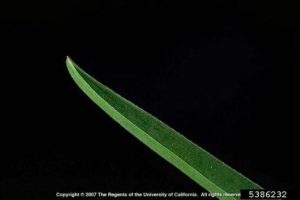Annual bluegrass (Poa annua L.) is an increasingly troublesome winter annual weed in some New Jersey blueberry fields. Native to Europe, this species is now worldwide distributed.
Identification and Life Cycle

Figure 1. Annual bluegrass. Thierry Besancon, Rutgers University
Annual bluegrass starts germinating in late summer as soil temperature drops below 70°F. If conditions are favorable, it will continue germinating throughout the winter. Annual bluegrass has light green leaves with a typical boat-shaped tip (Figures 1 and 2). Leaf blades are often crinkled part way down. It will produce greenish white inflorescences (seed heads) during the spring months. Annual bluegrass is a prolific and rapid seed-producing weed.
Each plant can produce up to 100 seeds that are viable just a few days after pollination, allowing multiple germination flushes during the cool season. Annual bluegrass tends to form dense clumps in areas with moist and/or compacted soil. Poor soil drainage, frequent irrigation, excessive fertilization, use of heavy equipment causing compaction, and shade are conditions that will encourage the development of annual bluegrass.

Figure 2. Annual bluegrass leaf tip. Joseph M. DiTomaso, University of California – Davis, Bugwood.org
Impact
While annual bluegrass may not be a strong competitor for blueberry bushes, it forms a dense mat that will persist until late spring. This mat will prevent proper application of residual herbicides in spring by intercepting the spray solution and reducing the amount of residual herbicide penetrating into the soil. Thus, control of established sod of annual bluegrass prior to spring herbicide applications is essential for successful residual weed control in spring and early summer.
Management
As for any other weed species, preventing the release of viable seeds that will replenish the soil seedbank is a primary objective for controlling this species. Cultivation or manual digging before annual bluegrass patches become well established and before the development of inflorescence will provide control of limited infestations if continued throughout the germination period. However, the use of chemical control may be required for large infested areas or where the species has become established for several seasons.
Application of effective preemergence herbicides may prevent annual bluegrass seedling survival. However, preemergence herbicides will not effectively control emerged plants. Timely application of preemergence herbicides is very important for effective control of annual bluegrass. Herbicides should ideally be applied in late-summer / early fall before annual bluegrass seeds germinate. However, crop injury may result if pre-emergence herbicides are applied at this time when blueberry bushes are not dormant. Therefore, a fall application of a preemergence herbicide tankmixed with a postemergence herbicide is often the most practical solution and should be considered when blueberry leaves start dropping.
- Preemergence herbicides such as oryzalin (Surflan), norflurazon (Solicam), or napropamide (Devrinol) may effectively control annual bluegrass. Application of these herbicides can be split between fall and spring applications with half of the yearly rate applied in fall and the second half in spring.
- Simazine (Princep) can provide early post-emergence control of leaf stage plants in addition to its residual activity.
- Pronamide (Kerb SC) is also an excellent option that will provide both residual and postemergence control of annual bluegrass. Optimum pronamide activity occurs when applications are made under cool temperature conditions (55°°F or less).
- S-metolachlor (Dual Magnum) is also effective at controlling annual bluegrass prior to germination. However, Dual Magnum can only be applied once per cropping season and will require grower to agree to the conditions of the indemnified label (https://www.syngenta-us.com/labels/indemnified-label-search).
All preemergence herbicides require incorporation from rainfall so that the herbicide can move into the first few inches of soil where it will be protected from degradation or volatility.
When annual bluegrass has emerged before residual herbicide is applied, a postemergence herbicide should be included in the tank. Use paraquat (Gramoxone or other labeled generic formulation) plus a nonionic surfactant at 0.25% v/v of the spray solution. Glufosinate (Rely 280) is also effective at controlling emerged annual bluegrass, especially when applied under bright sunlight, warm temperature, and high humidity conditions. Do not allow glufosinate spray mist to contact green bark, as injury will occur. None of the graminicides labelled on blueberry (Select, Poast) have sufficient activity for controlling annual bluegrass. The use of glyphosate (Roundup or other labeled generic formulation) is not recommended as failure to control emerged annual bluegrass has been reported in various New Jersey blueberry fields.
Consult the New Jersey Commercial Blueberry Pest Control Recommendations for rates and additional information (https://njaes.rutgers.edu/pubs/publication.php?pid=E265). As with all herbicides, read and follow all label instructions and precautions.

